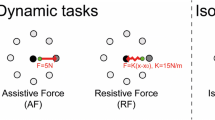Abstract
Although the order by which motor units are recruited, and the frequencies at which they fire, vary during different types of exercise, laboratory studies involving the electrical stimulation of muscle have never examined the effect of different orders of recruitment on muscular function. This has been due, principally, to the lack of an adequate technique capable of selectively stimulating discrete populations of motor units in a muscle having a mixed population of fibres. The paper describes a computer-controlled stimulator and special electrode array which can control the pattern of motor-unit recruitment during electrical stimulation of the lower leg of the cat. In addition, following a program of recruitment analogous to that which is believed to normally occur during voluntary isometric exercise, the computer was able to sustain isometric muscular contractions to fatigue at a variety of tensions with almost identical endurance times. as are found in man.
Sommaire
Malgré la variation de l'ordre, dans lequel les éléments moteurs sont mis en action et les fréquences réparties au cours de différentes sorties d'exercice, les études en laboratoire, impliquant la stimulation électrique du muscle, n'ont jamais examiné l'effet d'ordres différents de mise en action sur la fonction musculaire. Ceci est dû principalement au manque d'une technique adéquate, capable de stimuler sélectivement des populations discrètes d'éléments moteurs, dans un muscle possédant une population mixte de fibres. Ce résumé décrit un stimulateur contrôlé d'ordinateur et un groupement d'électrodes spécial, pouvant commander le modèle de mise en action des éléments moteurs, au cours de la stimulation électrique, sur la patte inférieure du chat. En outre, suivant un programme de mise en action analogue à celui que l'on croit voir apparaïtre normalement au cours d'un exercise isométrique volontaire, l'ordinateur a pu soutenir des contractions musculaires isométriques jusqu'à la fatigue, à une variété de tensions, avec des temps de résistance presqu'identiques à ceux trouvés chez l'homme.
Zusammenfassung
Obwohl die Reihenfolge, in der motorische Einheiten rekrutiert werden und die Frequenzen, bei denen sie zünden, sich während verschiedenartiger Betätigungen ändern, haben Laborstudien nit elektrischer Stimulation des Muskels nie die Wirkung unterschiedlicher Reihenfolgen der Rekruitierung der Muskelfunktion untersucht. Der Grund hierfür leight hauptsächlich im Nichtvorhandensein ädequater Techniken, durch die diskrete Populationen motorischer Einheiten im Muskel mit einer gemischten Population von Fasern selektiv stimuliert werden können. In diesem Papier wird ein computergesteuerter Stimulator mit spezieller Elektrodenanordnung beschrieben, durch den das Rekruitierbild der motorischen Einheiten während der elektrischen Stimulation des Unterbeins der Katze gesteuert werden kann. Zusätzlich konnte der Computer nach einem Programm analoger Rekrutierung dessen, von dem man annimmt, daß es normalerweise während freiwilliger isometrischer Übungen auftritt, isometrische Muskelkontraktionen bis zum Ermüden unter verschiedenen Spannungen mit fast identischen Ausdauerzeiten, wie sie beim Menschen gefunden werden, aufrecht erhalten.
Similar content being viewed by others
References
Bigland, B. andLippold, O. C. J. (1954) Motor unit activity in the voluntary contraction of human muscle.J. Physiol. 125, 322–335.
Brown, G. L., andBurns, B. D. (1949) Fatigue and neuromuscular block in mammalian skeletal muscle.Proc. Roy. Soc. B 136, 182–196.
Buller, A. J. andLewis, D. M. (1965) The rate of tension developed in isometric tetanic contractions of mammalian fast and slow skeletal muscle.J. Physiol. 176, 337–354.
Close, R. (1972) Dynamic properties of skeletal muscles.Physiol. Rev. 52, 129.
Dubowitz, V. andBrooke, M. (1974)Muscle biopsy, a modern approach Saunders, Philadelphia
Milner-Brown, J. S., andStein, R. B. (1975) The relation between the surface electromyogram and muscular force.J. Physiol. 246, 549–569.
Olson, C., Carpenter, D. andHenneman, E. (1968) Orderly recruitment of muscle action potentials.Arch. Neurol. 19, 591–597.
Peckham, P. H. (1976) Control of contraction strength of electrically stimulated muscle by pulse width and frequency modulation.Eng. Med. & Biol. 18, p. 116.
Petrofsky, J. S., Rinehart, J. S. andLind, A. R. (1976) Isometric strength and endurance in slow and fast muscles in the cat.Fed. Proc. 35, 291.
Rack, P. M. H. andWestbury D. R. (1969) The effects of stimulus rate on tension in the isometric contraction of the cat soleus muscle.J. Physiol. 204, 443–460.
Wuerker, R. R., McPhredran, A. M. andHenneman, E. (1965) Properties of motor units in a heterogeneous pale muscle (m. gastrocnemius) of the cat.J. Neurophysiol. 12, 28; 85–99.
Author information
Authors and Affiliations
Rights and permissions
About this article
Cite this article
Petrofsky, J.S. Control of the recruitment and firing frequencies of motor units in electrically stimulated muscles in the cat. Med. Biol. Eng. Comput. 16, 302–308 (1978). https://doi.org/10.1007/BF02442432
Received:
Issue Date:
DOI: https://doi.org/10.1007/BF02442432




